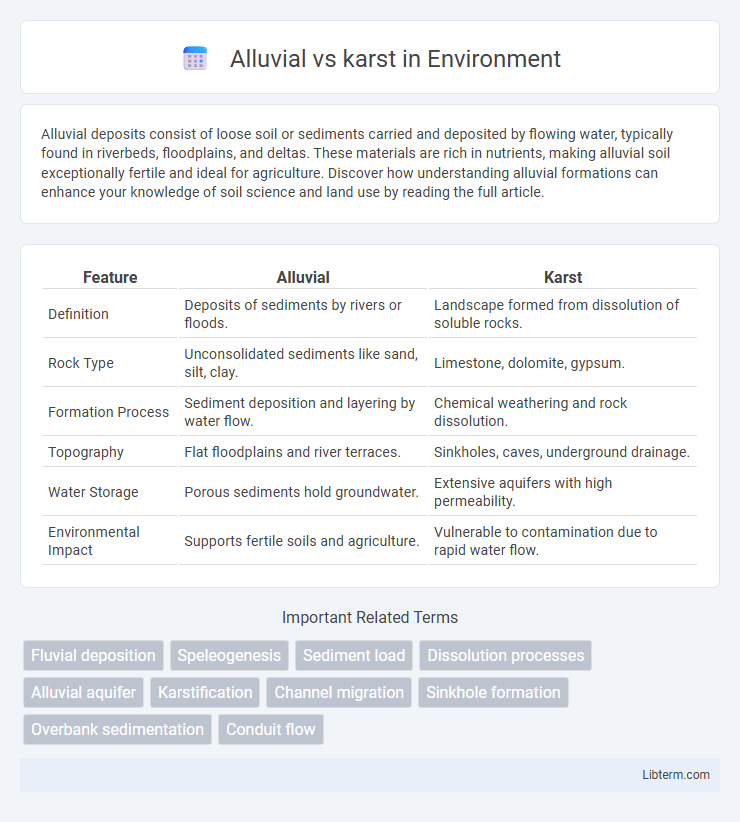Alluvial deposits consist of loose soil or sediments carried and deposited by flowing water, typically found in riverbeds, floodplains, and deltas. These materials are rich in nutrients, making alluvial soil exceptionally fertile and ideal for agriculture. Discover how understanding alluvial formations can enhance your knowledge of soil science and land use by reading the full article.
Table of Comparison
| Feature | Alluvial | Karst |
|---|---|---|
| Definition | Deposits of sediments by rivers or floods. | Landscape formed from dissolution of soluble rocks. |
| Rock Type | Unconsolidated sediments like sand, silt, clay. | Limestone, dolomite, gypsum. |
| Formation Process | Sediment deposition and layering by water flow. | Chemical weathering and rock dissolution. |
| Topography | Flat floodplains and river terraces. | Sinkholes, caves, underground drainage. |
| Water Storage | Porous sediments hold groundwater. | Extensive aquifers with high permeability. |
| Environmental Impact | Supports fertile soils and agriculture. | Vulnerable to contamination due to rapid water flow. |
Introduction to Alluvial and Karst Landscapes
Alluvial landscapes are formed by the deposition of sediments transported by rivers and streams, resulting in fertile plains and river valleys characterized by layered soils rich in silt, sand, and clay. Karst landscapes develop in regions of soluble rock, primarily limestone, where chemical weathering creates distinctive features such as sinkholes, caves, and underground drainage systems. These two landscape types exhibit contrasting geological processes: alluvial areas are shaped by sediment accumulation and water flow, while karst terrains evolve through dissolution and subterranean erosion.
Key Characteristics of Alluvial Environments
Alluvial environments are characterized by loose, unconsolidated sediments such as sand, silt, clay, and gravel deposited by running water, primarily rivers and streams. These areas exhibit high permeability and porosity, facilitating groundwater recharge and supporting fertile soils ideal for agriculture. In contrast to karst landscapes, which develop in soluble rock like limestone with features such as sinkholes and caves, alluvial systems lack significant chemical dissolution and display more uniform sediment layering.
Defining Features of Karst Terrains
Karst terrains are characterized by distinctive limestone dissolution features such as sinkholes, caves, and underground drainage systems formed through the chemical weathering of soluble rocks. Unlike alluvial landscapes dominated by sediment deposition from rivers and streams, karst regions exhibit irregular surface topography, with disappearing streams and extensive subterranean voids. These unique hydrological and geological features make karst terrains critical for groundwater storage and biodiversity but also prone to surface instability and sinkhole hazards.
Geological Formation Processes Compared
Alluvial formations develop through the deposition of sediments transported by water flow, typically in riverbeds, floodplains, and deltas, characterized by layered sand, gravel, silt, and clay. Karst landscapes form via the chemical dissolution of soluble rocks such as limestone, dolomite, and gypsum, leading to distinctive features like caves, sinkholes, and underground drainage systems. The key geological contrast lies in alluvium being sedimentary deposits from physical erosion and transport, whereas karst results from chemical weathering and rock dissolution processes.
Hydrology in Alluvial and Karst Systems
Hydrology in alluvial systems is characterized by porous sediments such as sand and gravel that allow rapid groundwater movement and easy recharge from surface water, creating productive aquifers with relatively predictable flow patterns. Karst systems feature dissolvable carbonate rocks like limestone, leading to complex underground drainage networks with sinkholes, caves, and conduits that cause highly irregular and rapid groundwater flow, complicating water resource management. The contrasting permeability and flow dynamics in alluvial versus karst aquifers significantly affect water availability, contamination risk, and recharge rates.
Soil and Sediment Differences
Alluvial soils consist primarily of fine silt, sand, clay, and gravel deposited by rivers and streams, resulting in fertile and well-drained sediments ideal for agriculture. Karst soils, formed from the dissolution of soluble rocks like limestone, are often shallow, rocky, and less fertile with irregular sediment distribution due to underground water erosion processes. The key difference lies in alluvial sediments being deposited on surface floodplains, while karst sediments develop in fractured bedrock with voids and subterranean drainage systems.
Biodiversity and Ecosystem Variations
Alluvial ecosystems, characterized by nutrient-rich sediments deposited by rivers, support diverse aquatic and terrestrial species due to fluctuating water availability and fertile soils. Karst landscapes, formed from soluble rock like limestone, host unique biodiversity including specialized cave fauna and endemic plants adapted to nutrient-poor, alkaline conditions. Ecosystem variations between alluvial and karst environments arise from differences in hydrology, soil chemistry, and habitat stability, influencing species composition and ecological interactions.
Human Activities and Land Use Impacts
Human activities such as agriculture, urban development, and mining drastically affect alluvial landscapes by disrupting sediment transport and groundwater recharge, leading to soil erosion and altered flood regimes. In karst regions, land use practices like quarrying, groundwater extraction, and construction cause subsidence, sinkhole formation, and contamination of fragile aquifers due to the porous limestone geology. Effective management of water resources and land planning is critical to mitigate these impacts in both alluvial and karst terrains.
Advantages and Challenges of Each Terrain
Alluvial terrains offer fertile soil due to deposited sediments, making them ideal for agriculture and groundwater recharge but face challenges like flooding and soil erosion. Karst landscapes provide unique aquifers with high water storage capacity and support diverse ecosystems, yet they are prone to sinkholes, water contamination, and difficult construction conditions. Understanding the hydrological and geological intricacies of alluvial and karst terrains is essential for sustainable land use and infrastructure development.
Summary: Choosing Between Alluvial and Karst Terrain
Alluvial terrain, characterized by sediment deposits from rivers, offers fertile soil and stable ground ideal for agriculture and construction, while karst terrain, formed by soluble rock erosion, features caves and sinkholes leading to complex groundwater systems and variable stability. Selecting between alluvial and karst areas depends on factors like groundwater management, soil fertility, and geotechnical risks, with alluvial regions preferred for predictable water supply and karst areas requiring thorough geological surveys due to potential subsidence. Understanding hydrogeological properties and land use goals ensures the most suitable terrain choice for sustainable development.
Alluvial Infographic

 libterm.com
libterm.com